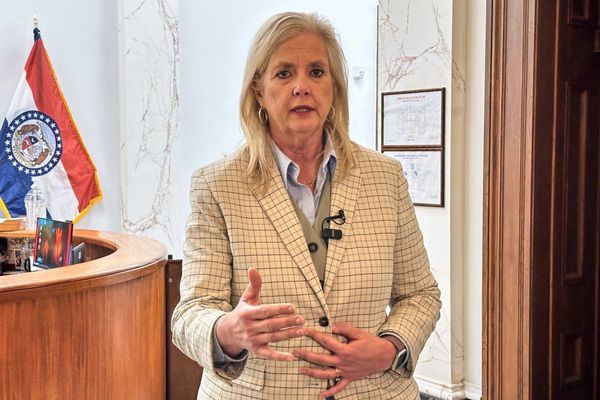
While appearing on a podcast recently to publicise her first book, Eve: How the Female Body Drove 200 Million Years of Evolution, Cat Bohannon found herself having to reassure the pregnant producer. In the book, which puts women back at the heart (and brain, and womb) of our evolutionary story, Bohannon describes pregnancy as “a dance between what the mother’s body needs and what her hungry offspring need, with each accommodation skirting just on the edge of killing one or both of them”.
At each stage, Bohannon makes clear just how unlikely human survival has been, with our narrow pelvises, huge heads, needy babies and hungry brains. And so, she argues, the innovations that have allowed our species to survive and flourish were not the spear, the wheel or the internet, but midwifery and gynaecology, wet nursing and prenatal care. Without our super-social cooperation, we’d have disappeared back in prehistoric Africa, leaving barely a fossil.
It’s easy to understand why the producer had fallen silent. “She was eight months pregnant,” Bohannon recalls. “And so, at the very end, I was like, ‘You’re gonna be fine! Everything’s going to be great! Well, it’s not going to be super fun for those few hours, and then there’s motherhood, which is also complicated. But you’re going to be very much alive!’”

Eve is a hugely ambitious piece of work, and one that doesn’t pull its punches. It took Bohannon 10 years to research and write – though, to be fair, that was at the same time as earning a PhD, living through a pandemic and having two children. The book sets out to turn our male-centric understanding of the human body, and history, on its head. Bohannon creates female characters out of our earliest common ancestors, and rewrites the opening scene of Stanley Kubrick’s 2001: A Space Odyssey, to argue that perhaps it was women who led the development of language, tools and walking on two legs.
Moving between evolutionary biology, physiology, paleoanthropology and genetics, from the Jurassic period to the most cutting-edge scientific research, this page-turning history of the human mammal describes seven main characters: our ancestral “Eves”, as Bohannon calls them. In the beginning, there was “Morgie” (Morganucodon), an egg-laying cross between a weasel and a mouse that was probably the first creature to lactate. More than 200m years later, Morgie’s breastfeeding descendants are so sophisticated that a mother’s body can change the composition of its milk in response to hormonal messages in the baby’s saliva.
Character and storytelling are clearly second nature to Bohannon. She was born in Atlanta, Georgia; her father was a psychology professor at Emory University, her mother a pianist. “My puberty years were spent helping to prep slides for my father’s experiments,” she says. “I was a subject long before I was a researcher.” She skipped ahead a couple of years in school, dropped out, played in bands and went to the University of East Anglia to study poetry under Andrew Motion. Then she took an MFA at Columbia in creative nonfiction, and her PhD was in the evolution of narrative and cognition.

Bohannon’s course was officially based in the English department, but she worked in psychology labs, running experiments using natural language processing and writing computer programmes to turn thousands of novels from Project Gutenberg into data. (She knows a lot about the language of sex scenes over the past 400 years.) One evening at a party she got chatting to a neuroscience postdoc who had, during an experiment, happened to look for some sex differences in responses in mice. He was shocked to find “huge significance in the data”, but his principal investigator, a Nobel laureate, advised him to ignore it. The science is seductively easier to do, “cleaner”, if you put the potential variation between the sexes to one side. That’s why the so-called “male norm” predominates in research, skewing results, and therefore the knowledge and treatments that emerge.
As Caroline Criado Perez revealed in her Royal Society prize-winning 2019 book, Invisible Women, and as Bohannon herself discovered, the issue of females being excluded from scientific research is huge. “It’s not just a cultural problem,” Bohannon says. “This isn’t just classic sexism. It’s that even when scientists are trying to do it right, the data just isn’t there.”
Bohannon spent years reading the latest papers and grilling scientists about their work, in her attempt to redress this imbalance. She discovered, for example, that women have better hearing, and at higher frequencies, than men. That women are more likely to die of heart attacks, even though they are less likely to have them. And that in the US, the risk of maternal death has actually increased in recent years, “quite unlike every other industrialised nation that isn’t presently at war”. The significance of this research to our understanding of women’s bodies and health is clear. But still, she’s nervous. “Obviously I’m going to be called all kinds of things because the internet is what it is,” she sighs.
In the end, though, she found writing the book “very freeing”. “As this woman with a very feminine body, it was wonderful to look at my fat ass and think, ‘Oh, I know where you came from!’” She’s talking about the particular type of fat that’s stored around women’s hips, buttocks and upper thighs, which is full of the lipids that a developing baby needs to build its brain and retinas. This is the fat that’s often removed during liposuction – so might that pose a problem for a woman who goes on to become pregnant? We don’t know. Once again, we just don’t have the data.

There was one particular chapter, however, that Bohannon dreaded working on. In the section about the brain, she writes: “My task, you see, is to wrestle with whether men’s and women’s brains are functionally different and, if they are, whether those differences are tied to something innate. Each part of that task is surrounded by a sociopolitical gender debate so dense it threatens to obscure the science.” She was intrigued to find that male and female brains are strikingly similar in humans – much more so than in some other mammals. Our voices and hearing, on the other hand, show far greater variation. And could it not make sense that women’s voices, which have crooned to nursing babies for millions of years, and their ears, which interpreted their infants’ cries, might have been the first to form words and grammar?
The cultural pressure on scientific research comes up again when I ask if Bohannon is bracing for flak about any part of the book. Writing it, she replies carefully, “was emotionally difficult because I want women and girls of all types to live better lives. And I don’t want to be part of the problem. And there are lots of people who are going to weaponise science against the bodies of marginalised folk.” She clarifies: “What I mean by that is eugenics was not that long ago. The idea that hysteria was driving the female psychological experience was not that long ago. I mean, God, it was not that long ago that homosexuality was in the DSM [the Diagnostic and Statistical Manual of Mental Disorders].” She was warned, she says, about including transgender bodies in the narrative. But about that, she seems less hesitant. “People who work in the sciences, myself included, are not in the business of definitions,” she says. “We’re here to tell you what the shape of the curve is.”
It’s a book that’s packed full of surprising revelations. There’s women’s ability to outperform men in endurance sports, for example. Or the fact that 12% of girls may be born with the physiology to see 99m more distinct colours than the average human: a latent superpower. But perhaps the most shocking thing to be reminded of is how recent we are, compared to the long-gone Eves that Bohannon describes. Life has been around on Earth for a couple of billion years; anatomically modern humans for a mere 300,000. It’s easy for us to see ourselves as the end point of evolution – the pinnacle of what embodied brains can be. Does getting to know our ancestors put Homo sapiens into context?
“It’s made me more of an optimist,” Bohannon says. “I’m very anti-teleology, in that I don’t think we were the obvious candidate for success. Nor are we the obvious candidate for success going forward: we have the numbers right now, but we are incredibly self-defeating as a species.” What we are good at, however, is problem solving, and for that humans need to work together. Bohannon hopes her book will give readers new ways of thinking about our bodies, and what it means to live in them, and believes that our uniquely human cooperation is the way we’ll overcome the divisions that hold us all back. Eve has already been translated into 23 languages, so perhaps she’s right to be hopeful. Making an “egalitarian society is part of how we’re going to be able to survive the very obvious problems that are coming at us,” she says. That project requires everyone – male and female, playing to our strengths – to pull together.
• Eve: How the Female Body Drove 200 Million Years of Human Evolution by Cat Bohannon will be published by Hutchinson Heinemann on 12 October. To support the Guardian and Observer, order your copy at guardianbookshop.com. Delivery charges may apply.







